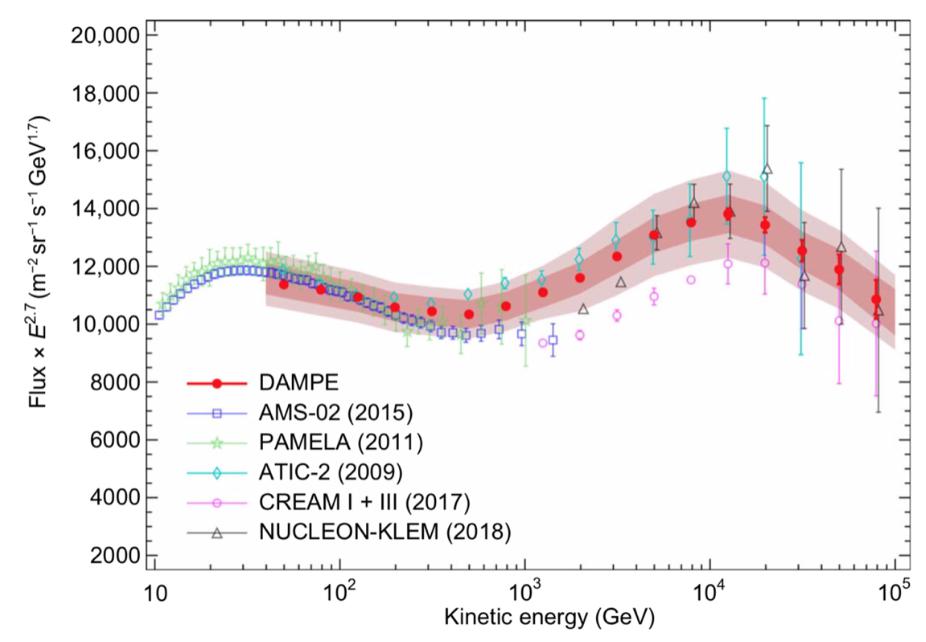
Recently, the DAMPE team led by Prof. HUANG Guangshun and ZHANG Yunlong from the University of Science and Technology of China (USTC) of the Chinese Academy of Sciences has reported the measurement of the cosmic ray proton fluxes with kinetic energies from 40 GeV to 100 TeV, with 2.5 years of data recorded by the Dark Matter Particle Explorer (DAMPE, also known as “Wukong” in China). This is the first time that an experiment directly measures the cosmic ray protons up to ~100 TeV with high statistics. The study was published in Science Advances.
The precise measurement of the spectrum of protons, the most abundant component of the cosmic radiation, is necessary to understand the source and acceleration of cosmic rays (CRs) in the Milky Way. The diffusive transportation of CRs in the interstellar turbulent magnetic field results in a softening of the accelerated spectrum. The general picture of CR production and propagation has been supported by measurements of CR energy spectra and composition ratios, as well as diffuse gamma rays.
However, such a simple picture has been challenged by some recent high-precision measurements. The precise measurements of the energy spectra of CRs above tera–electron volts are motivated by the test of potential new spectral features. According to the former research, the calorimeter-based direct measurement experiments, with high statistics up to 100 TeV and well-controlled systematic uncertainties, are most suitable to solve the above problems.
In this study, the researchers presented the measurement of the proton spectrum with the DAMPE. DAMPE is a calorimetric-type, satellite-borne detector for observations of high-energy electrons, gamma rays, and CRs. The data used covered the first 30 months of operation of DAMPE. The proton spectrum in the energy range is from 40GeV to 100 TeV. A spectral hardening at a few hundred giga–electron volt energies was in agreement with that of PAMELA and AMS-02, the experiments led by DING Zhaozhong.
These results confirmed the spectral hardening at ~300 GeV found by previous experiments and revealed a softening at ~13.6 TeV, with the spectral index changing from ~2.60 to ~2.85. And they suggested the existence of a new spectral feature of cosmic rays at energies lower than the so-called knee and sheds new light on the origin of Galactic cosmic rays. This new structure is likely to be a mark left by a neighboring cosmic line source whose upper limit of energy acceleration corresponds to the inflection energy.
The DAMPE dark matter satellite was successfully launched on December 17, 2015. The bismuth germanate (BGO) energy meter of its load core subsystem is developed by the State Key Laboratory of Particle Detection and Electronics. It is a detector with the best energy resolution and the strongest particle discrimination ability. The results of the DAMPE are of great significance for revealing the origin of the high-energy cosmic rays and the acceleration mechanism.
Prof. HUANG Guangshun from USTC is the deputy general manager of the DAMPE satellite engineering science application system. ZHANG Yunlong is the convener of the cosmic ray analysis group. He led the team to develop the DAMPE scientific data analysis software and developed a rich BGO energy meter. The track performance calibration and data analysis methods have achieved high-precision energy reconstruction. The research team is one of the independent data analysis teams in the International Cooperation Group for Dark Matter Particle Detection Satellites, and has made important contributions to scientific data analysis.

Proton spectrum from 40 GeV to 100 TeV measured with DAMPE (red filled circles). (Image from DAMPE collaboration)

86-10-68597521 (day)
86-10-68597289 (night)

52 Sanlihe Rd., Xicheng District,
Beijing, China (100864)

